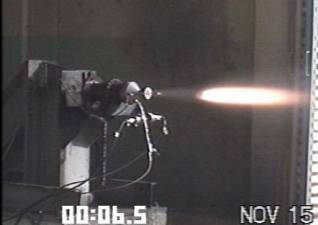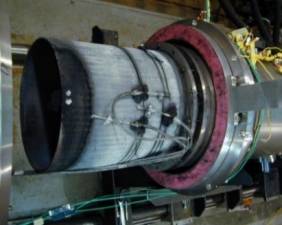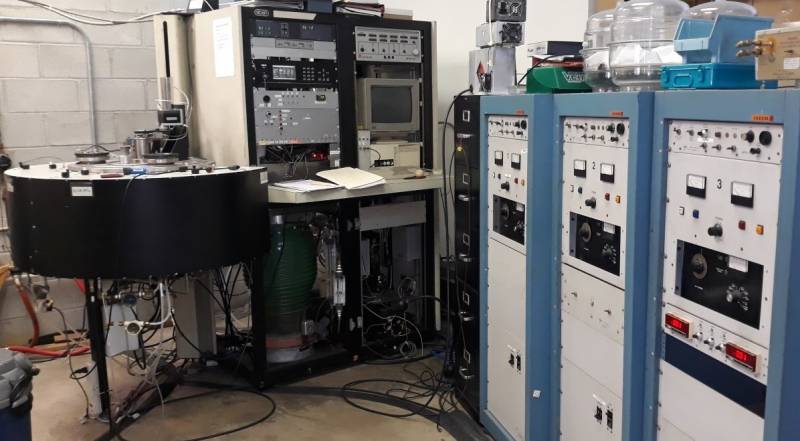SINTX has a long history of developing composites and coatings for extreme environments. Our 30 years of experience has allowed us to gain expertise with both C and SiC fibers, debond coatings including carbon and SiC, dozens of different options for the composition and the production process for the ceramic matrix, and a wide array of final barrier coatings.
Our Ceramic Matrix Composite (CMC) experience initially was focused on Carbon/SiC and SiC/SiC based formulations, but this material family has a wide array of options which tailor the properties such as density, strength, oxidation resistance, and wear resistance. Additional options are available by using layering or functional grading, allowing the final composite to exhibit properties that cannot be achieved with monolithic materials or simpler composites. These attributes offer significant payoffs in performance and efficiency for commercial and military aircraft, rocket nozzles, nuclear reactors, and a host of other emerging applications.
CMC Fabrication
SINTX has developed several approaches to fabricating CMCs using Chemical Vapor Infiltration (CVI) and Polymer Infiltration and Pyrolysis (PIP).
- Isothermal
- Pulsed Pressure
- Reverse Thermal Gradient (RTG)
- Rapid Densification Gas Pulsed-RTG
- PIP + CVI
What sets SINTX apart?
- Toll processing as well as full process development
- Extensive expertise in fixture and susceptor design
- Large CVD/CVI chambers
- Multiple options to customize coating and infiltration conditions
Example applications
SINTX fabricated CMC components via a low-cost, rapid CVI process based on a gas-pulsed, reverse thermal gradient CVI (GP-RTG CVI) for the following applications:- Hypersonic propulsion, “zero erosion” nozzle liner
- Divert attitude propulsion (DACS) thrusters and lightweight injectors
- Ion optics C(ϝ)/C grids
- Graded Cf- SiC/HfC CMCs for Liquid Rocket Nozzles
Highlighted project - Lightweight, Long Life (Cooled) Thrust Cells
Objective:- To establish multiple-use thrust cells for 3rd generation RLV applications
- Establish cooled composite designs for use with LH₂/LOₓ fuels
- Demonstrate firing of liquid H₂ cooled CMC design
- C(f)/C-HfC₉₀/SiC₁₀ was selected and tested
- Three nozzles were fabricated and tested, surviving for more than 250 seconds at 4700˚F
- At chamber pressures of 500psi, CMC showed gas permeability
- No throat erosion was observed following 250 seconds at 4700˚F
CERAMIC COMPOSITES (CVI-PIP) and COATING (CVD)
C(f) or SiC(f) - C, SiC, HfC, ZrC, NbC, TaC, TiC, B4C, HfB2, Mo,Zr,Hf Ir, Nb, Re
Fabrication of CMC components via a low-cost, rapid CVI process based on a gas-pulsed, reverse thermal gradient CVI (GP-RTG CVI)
- Hypersonic propulsion, “zero erosion” nozzle liner
- Divert attitude propulsion (DACS) thrusters
- Ion optics C(ϝ)/C grids
- Long-life, fiber interface coatings
- Lightweight injectors for DACS
- Graded Cf- SiC/HfC CMCs for Liquid Rocket Nozzles
Low-Cost Approach to CMCs
Develop processing approaches to fabricate CMCs at significantly lower costs than by conventional means
- Large ∆T – directional matrix growth, Functionally Graded Matrices
- Higher T&P – higher matrix growth rate
- Colder surface – maintains open surface porosity
- Cycling P – maintains high matrix growth rates
- Reactant consumption reduced considerably
- Allows variable matrix architectures
- Reduced processing/component costs
- Six-fold reduction in time, ten-fold reduction in cost
Ceramic Composites
Ceramic composites are hybrid materials that combine ceramic with metal, ceramic with ceramic, ceramic with plastic, or ceramic with other ceramic materials. By combining different ceramic materials, these advanced composite materials often possess superior strength and properties that far exceed those of individual components. Developments in ceramic composite technology have made possible a wide range of new practical applications in the automotive, aerospace, electrical/electronic and medical industries. While still expensive to produce due to the complexity of their manufacture, ceramic composites are being used increasingly by manufacturers who require high-performing components for specific functions. These advances have helped open a whole world of possibilities for complex structures and more efficient design solutions.
Ceramic Matrix Composite
For those looking to transport more heat and stress with ceramic materials, ceramic matrix composites (CMC) are the ideal choice. CMCs are constructed of ceramic fibers held together by ceramic or metal binders. This combination of ceramic and metal creates a material that is strong enough to withstand extreme temperatures and pressure while also lightweight enough for easy use and transportation. This versatility has made ceramic matrix composites a popular choice among automotive engineers, aerospace fabricators and other industries that rely on performance from ceramic materials.
CMC Fabrication
CMC fabrication is an attractive option for many engineering projects since CMCs are often light, strong, and resistant to high temperatures. CMC fabrication is a complex procedure that utilizes advanced technologies such as CMC powders, "laser processing," advanced metrology equipment, and mathematical analysis to ensure the CMC takes on the desired properties. TA&T’s CMC fabrication methods also involve joining CMCs components with other materials and processes such as infiltrating CMC preforms into a metal matrix or laminating thin layers of CMCs together to create multi-layer composites. When you need to manufacture lightweight, reliable parts even in sharply featured shapes through reliable replications, choose CMC fabrication.
Carbon Composites
Carbon composites are materials composed of carbon molecules that have been arranged in a specific pattern to create a durable material. Often found in the construction and design of airplanes, boats, and other various industries, carbon composite materials differ from standard materials because they possess increased strength, durability, and greater chemical resistance. Carbon composites' unique properties account for their wide range of applications; they are used to not only reinforce existing structures but also create lighter weight objects with an improved strength-to-weight ratio. Carbon composites are becoming more prevalent due to their versatility and dependability in aerospace, sports equipment, medical tools and implants, automotive parts, and more. This amazing material continues to revolutionize our world with its plethora of uses, and TA&T makes it easy to take advantage of all of these possibilities in your business.
Ceramic Components
Ceramic components are an invaluable resource for a variety of markets, due to their high strength-to-weight ratio and superior electrical insulation. Ceramics offer strong impact and wear resistance, as well as excellent thermal shock resistance. From ceramic capacitors for radar systems to ceramic brakes for automobiles, TA&T’s ceramic components provide a robust solution for many everyday items and cutting-edge technologies alike. Furthermore, ceramic materials are recyclable, eliminating any negative environmental consequences from their production or processing. With ceramic’s versatility it is no wonder that its importance in industry continues to rise.
Functionally Graded Material (FGM)
| X |
p (g/cc) Monolith |
p (g/cc) Cf/X |
p (g/cc) Cf/C-X |
p (g/cc) Cf/SiC-X |
|---|---|---|---|---|
| C | 1.8 – 2.1 | ~1.95 | ~1.95 | - |
| SiC | 3.22 | 2.25 | 1.81 | - |
| Re | 20.53 | 10.04 | 3.37 | 3.85 |
| HfC | 13.31 | 6.79 | 2.72 | 3.17 |
Assume: 40 vol% fibers and 15% porosity
Lightweight, Long Life (Cooled) Thrust Cells
Objective:
- To establish multiple-use thrust cells for 3rd generation RLV applications
- Establish cooled composite designs for use with LH₂/LOₓ fuels
- Demonstrate firing of liquid H₂ cooled CMC design
Results:
- C(f)/C-HfC₉₀/SiC₁₀ was selected and tested
- Three nozzles were fabricated and tested – surviving for more than 250 seconds at 4700˚F
- At chamber pressures of 500psi, CMC showed gas permeability
- No throat erosion was observed following 250 seconds at 4700˚F
Lightweight, Long Life (Cooled) Thrust Cells
Objective:
- Demonstrate low-cost, rapid CVI process for the fabrication of C(r)/SiC DACS thrusters
- Demonstrate significant cost reduction over existing Noveltex DACS thrusters (THAAD)
- Establish TA&T as a low-cost, second-source supplier of CMC DACS thrusters
Results:
- Established a rapid CVI process based on GP-RTG CVI
- Densified C(r)/SiC thrusters to ~85% in less than 40 hours
- Developed fully automated process control system for majority of CMC processing
- Demonstrated directional matrix growth and optimized process for DACS thrusters
PVD Magnetron Sputtered Coatings
Magnetron sputtered coatings – multilayered:
- Residual stresses significantly influence the coating bulk properties
- Developing process control to determine residual stress, texture, surface roughness, etc. of coating during growth
Properties:
- Thermal EBCS for SiC CMCs up to 2850oF
- Wear resistance – B₄C/SiC, B₄C/W, etc.
- Solid Lubrication – MoS₂/Au-Pd
- Quasicrystalline/Nanocrystalline coatings
- CrN/Cr2N Corrosion Resistant
Ready to Take Advantage of TA&T’s Composites & Coatings?
Our ceramic composites & coatings can help take your product to the next level. Give superior quality needing to drastically alter your existing business model or expand your space. Contact our team of experts today for more information and to get started.
Contact Us

